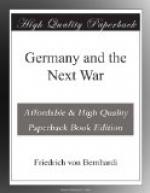An immense apparatus of train formations, railway and telegraph corps, and workmen must be got ready to secure the efficiency of a modern army with its millions. This is absolutely necessary, since without it the troops in modern warfare would be practically unable to move. It is far more important to be ahead of the enemy in this respect than in any other, for there lies the possibility of massing a superior force at the decisive point, and of thus defeating a stronger opponent.
However careful the preparations, these advantages can only be attained if the troop columns do not exceed the maximum strength which can be fed from the rear, if the necessary forward movement is carried out. Everything which an army corps requires for the war must be kept within these limits.
Our modern army corps without the heavy artillery of the field army corresponds roughly to this requirement. But should it be lengthened by a heavy howitzer battalion, with the necessary ammunition columns, it will considerably exceed the safe marching depth—if, that is, the necessary advance-guard distance be included. Since, also, the infantry is too weak in proportion to the space required by the artillery to deploy, it becomes advisable in the interests both of powerful attack and of operative efficiency, within the separate troop organizations to strengthen the numbers of the infantry and reduce those of the artillery.
In addition to the length of the column, the arrangement of the division is very important for its tactical efficiency. This must be such as to permit the most varied employment of the troops and the formation of reserves without the preliminary necessity of breaking up all the units. This requirement does not at all correspond to our traditional organization, and the man to insist upon it vigorously has not yet appeared, although there can be no doubt as to the inadequacy of the existing tactical organization, and suitable schemes have already been drawn up by competent officers.




